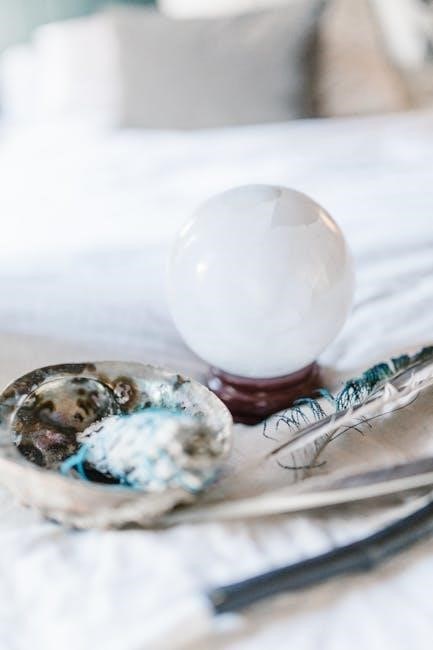Vastu Shastra, an ancient Indian science, emphasizes harmonizing buildings with nature and cosmic energies. It balances five elements—earth, water, fire, air, and space—for prosperity and well-being.
What is Vastu Shastra?
Vastu Shastra is an ancient Indian architectural science that focuses on designing buildings in harmony with natural and cosmic forces. It emphasizes balancing the five elements—earth, water, fire, air, and space—to create environments that foster health, happiness, and prosperity. This traditional system provides guidelines for constructing homes, offices, and public spaces, ensuring they align with nature’s energy, or “prana,” to enhance the well-being of occupants. Its principles are rooted in Hindu philosophy and are widely applied in modern architecture for holistic living.
Origins and History of Vastu Shastra
Vastu Shastra, an ancient Indian architectural science, traces its origins to the Vedas and Puranas, dating over 6,000 years. Rooted in Vedic knowledge, it was formalized by sages like Viswakarma and Maya, who detailed construction principles for temples and palaces. Originally a guide for sacred structures, it evolved to include residential and public buildings. This timeless wisdom integrates cosmic energies, nature, and human needs, evolving through centuries while maintaining its core principles of harmony and balance.
Importance of Vastu Shastra in Modern Life
Vastu Shastra remains highly relevant in modern life, offering practical solutions for harmonizing living and working spaces. By balancing the five elements, it enhances well-being, productivity, and positivity. Its principles guide optimal use of natural light, ventilation, and energy flow, creating spaces that align with human needs and environmental harmony. Many people today adopt Vastu tips to improve health, wealth, and relationships, making it a timeless guide for contemporary lifestyles and architectural designs.

The Five Elements of Vastu Shastra
The Five Elements of Vastu Shastra are Earth, Water, Fire, Air, and Space. They are essential for balancing energies and creating harmony in living spaces.
Earth (Prithvi)
Earth (Prithvi) represents stability and strength in Vastu Shastra. It is associated with the south-west direction and is linked to grounding energies. Heavy furniture and structures should be placed in this zone to enhance stability. Earthy colors like brown and beige are recommended to balance this element. Proper alignment with Earth ensures emotional and financial grounding, promoting harmony and prosperity in living spaces. It is crucial to avoid disturbances like underground water in the south-west to maintain Earth’s positive influence.
Water (Jal)
Water (Jal) in Vastu Shastra symbolizes fluidity and abundance, associated with the north direction. It enhances prosperity and calmness when placed correctly. Aquariums or fountains in the north attract positive energy and wealth. Avoid placing water elements in fire zones to prevent energy conflicts. Blue and light colors are ideal for this element. Proper placement ensures emotional balance and financial growth, while clean water storage in the north-east promotes harmony and well-being in living spaces.
Fire (Agni)
Fire (Agni) in Vastu Shastra represents energy, passion, and transformation. It is associated with the south-east direction and governs creativity, vitality, and purification. Placing the kitchen in the south-east aligns with Agni’s energy. Avoid placing water elements in fire zones to maintain balance. Use triangular shapes and warm colors like red and orange to enhance this element. Lighting, such as candles or lamps, in the south-east can activate positive energy. Proper placement ensures harmony, prosperity, and vitality in living spaces, while misalignment may lead to conflict and instability.
Air (Vayu)
Air (Vayu) in Vastu Shastra symbolizes movement, communication, and intellectual growth. It is associated with the north-west direction, governing clarity and freshness. Proper ventilation enhances Vayu’s energy, promoting mental clarity. Avoid clutter in this zone to ensure smooth airflow. Use light colors like green or beige to balance this element. Placing plants or open spaces in the north-west can harmonize Vayu, fostering positive energy and mental well-being. Proper alignment of this element is crucial for maintaining a peaceful and refreshed living environment.
Space (Akash)
Space (Akash) in Vastu Shastra represents the infinite and the void, symbolizing freedom and expansion. It is associated with the center of the plot, governing clarity and spiritual growth. An open, uncluttered center enhances positive energy flow. Avoid heavy structures or obstructions in this area to maintain balance. Light colors and minimal furniture are recommended to keep the space energized. Akash is crucial for mental peace and clarity, making it vital to ensure its harmony in any living or working space for overall well-being and prosperity.
Balance of the Five Elements
Balancing the five elements—Earth, Water, Fire, Air, and Space—is central to Vastu Shastra. Each element must be in harmony to create a conducive environment. Imbalance can lead to negativity and stagnation. Earth provides stability, Water energizes, Fire ignites passion, Air refreshes, and Space liberates. Proper alignment ensures prosperity, health, and peace. Techniques like directional placement, color schemes, and material selection help maintain equilibrium. This balance fosters holistic well-being, making it essential for designing living and working spaces according to Vastu principles.

The 16 Zones in Vastu Shastra
The 16 zones in Vastu Shastra represent specific areas of a property, each with unique significance. They guide the optimal placement of rooms and elements for harmony and prosperity.
Zone 1: Entrance and Main Door
The entrance and main door are crucial in Vastu Shastra, as they welcome positive energy into the home. Ideally, the main door should face north, east, or northeast for prosperity. Avoid placing the door under a staircase or opposite another door. A south-facing entrance is considered less favorable. Placing a nameplate, auspicious symbols, or a Ganesha statue near the entrance enhances positive vibes. Ensure the door is sturdy, well-lit, and free from obstructions like trees or pillars. A clean and welcoming entrance fosters harmony and good fortune.
Zone 2: Living Room
The living room, a space for social interactions, should ideally be located in the northeast or northwest of the house. Place heavy furniture like sofas in the south or west to create stability. Avoid positioning furniture under beams, as it can cause tension. Use calming colors like cream or light blue to enhance harmony. Ensure the room is well-ventilated and illuminated naturally. Avoid placing mirrors directly opposite the entrance, as they reflect positive energy away. Incorporate plants or a small fountain to boost positivity and balance the energy in the space.
Zone 3: Kitchen
The kitchen, a space for nourishment, should ideally be placed in the southeast direction to align with the fire element. Ensure the cooking stove is in the southeast corner, avoiding water sources in this zone. Keep the kitchen clean and clutter-free to enhance positive energy. Use warm, inviting colors like orange or yellow. Avoid placing the kitchen under a staircase or adjacent to the bathroom. Incorporate proper ventilation to remove negative energies. Position storage areas in the southwest or northwest for stability. Maintain a balanced layout to foster harmony and prosperity in the household.
Zone 4: Bedroom
The bedroom should be located in the southwest direction for stability and strength. Place the bed away from the door and avoid mirrors directly opposite the bed. Use calming colors like light blue or green to create a soothing atmosphere. Ensure the bedroom is clutter-free to promote positivity. Avoid placing the bed under a beam or in a corner. Opt for soft lighting and natural materials for furniture. Maintain a serene environment to enhance relaxation and intimacy. Proper placement ensures restful sleep and strengthens relationships.
Zone 5: Bathroom
In Vastu Shastra, the bathroom should ideally be located in the northwest or southeast direction to ensure proper energy flow. Avoid placing it in the northeast, as it can disrupt spiritual growth; The toilet should not face the main door or be placed under a staircase. Use light, calming colors like white or cream for the walls. Ensure proper ventilation to remove negative energies. Avoid mirrors directly opposite the door. Place the shower or faucet in the northeast to align with the water element. Keep the bathroom clean and clutter-free to maintain positive energy.
Zone 6: Pooja Room
The Pooja Room should be placed in the northeast direction, considered the most sacred spot for spiritual practices. Use light colors like white or cream to enhance positivity. Avoid placing the Pooja Room under a staircase or adjacent to a bathroom. Keep idols facing east or north for divine energy alignment; Ensure the room is clutter-free and well-ventilated. Place a small fountain or water element nearby to enhance harmony. Avoid mirrors directly opposite the door to prevent negative reflections. This zone fosters spiritual growth and peaceful ambiance.
Zone 7: Study Room
The Study Room should ideally be placed in the northeast or east direction to enhance concentration and knowledge absorption. Use earthy tones like brown or beige for walls. Avoid placing the study table under a beam or in a corner. Ensure the desk faces north or east for better focus. Keep books and stationery organized to avoid clutter. Incorporate a small plant like a money plant for positivity. Avoid placing the study room adjacent to bathrooms or under stairs. Proper lighting and ventilation are essential for productivity and mental clarity.
Zone 8: Dining Room
The Dining Room should ideally be placed in the east direction to foster positive energy and family bonding. Place the dining table in the center, avoiding walls to ensure free movement. Use warm, earthy tones like beige or brown for walls to create a welcoming ambiance. Avoid placing the dining table under a beam or in a corner. Ensure proper lighting and ventilation for a pleasant atmosphere. Keep the dining area clutter-free and avoid placing TVs or computers here to encourage family interaction. Incorporate a small water feature or plant for harmony and prosperity.
Zone 9: Garden
The garden, or Zone 9, should ideally be located in the east or north direction to maximize positive energy. Plant tall trees in the southwest to balance the plot and avoid blocking natural light. Use flowering plants and herbs like Tulsi in the northeast for spiritual benefits. Incorporate a small water feature or fountain in the northeast or east to enhance prosperity. Avoid placing cacti or thorny plants near the entrance, as they are believed to attract negative energy. Keep the garden well-maintained and vibrant to promote harmony and well-being.
Zone 10: Storage
Storage areas, or Zone 10, should be placed in the southwest or northwest of the house to ensure stability and security. Heavy items like furniture or machinery are best stored here to ground the energy. Avoid storing waste or unused items in the northeast, as it can obstruct positive energy flow. Keep the space organized and clutter-free to maintain harmony. Use lockers or shelves to store valuable items securely. Ensure proper ventilation to prevent stagnation. This zone plays a crucial role in maintaining balance and prosperity in the home. Regular cleaning is essential to avoid negative energy accumulation.
Zone 11: Balcony
The balcony, or Zone 11, is ideal in the north, northeast, or east for natural light and ventilation. Avoid placing it in the south or southwest to prevent negative energy. Decorate with plants like basil or tulsi for positivity. Use light colors and avoid heavy furniture. Ensure the balcony is clean and clutter-free to enhance harmony. This zone connects indoors with nature, promoting well-being and tranquility. Properly designed, it amplifies positive energy and aesthetic appeal, creating a serene outdoor space for relaxation and enjoyment. Regular maintenance ensures optimal energy flow and balance.
Zone 12: Garage
The garage, or Zone 12, is best situated in the northwest or southeast to ensure balanced energy. Avoid placing it directly opposite the main entrance to prevent negative energy flow. Keep the garage clean and clutter-free, as stagnation can hinder prosperity. Use light colors for walls to enhance positivity. Avoid storing junk or unused items here, as it attracts stagnant energy. Proper organization and regular maintenance are crucial to maintain harmony. This zone should reflect order and functionality, supporting the overall energy balance of the home. A well-designed garage fosters stability and prosperity.
Zone 13: Entrance Lobby
The entrance lobby, or Zone 13, is a vital area as it sets the tone for the entire home. Ideally located in the north or east direction, it should be welcoming and clutter-free. Use bright, uplifting colors like yellow or cream to enhance positivity. Place a small plant or a deity like Ganesha here to attract good fortune. Avoid placing mirrors or heavy furniture in this zone, as they can create negative energy. Ensure the lobby is well-lit and organized to promote harmony and prosperity from the moment one enters. Proper alignment here fosters a positive first impression.
Zone 14: Staircase
The staircase, or Zone 14, is a transitional space that connects different levels of a building. According to Vastu Shastra, staircases should ideally be located in the southwest or northwest to maintain positive energy flow. Avoid placing staircases in the southeast, as this can disrupt the fire element. Spiral staircases are discouraged, as they are believed to obstruct energy flow. Ensure the staircase is well-lit and made from natural materials like wood or stone. Keeping this area clutter-free and clean enhances the overall energy of the space. Proper placement ensures smooth movement and harmony within the home.
Zone 15: Terrace
In Vastu Shastra, the terrace, or Zone 15, is considered an open space that connects residents to nature. It should ideally face north, east, or northeast to harness positive energy. Avoid constructing terraces in the southwest or southeast, as this can lead to energy imbalances. Keep the terrace clutter-free and use plants or greenery to enhance positivity. Water features, like small fountains, can be placed in the northeast for prosperity. Ensure the terrace is well-ventilated and avoids heavy furniture, promoting harmony and relaxation. Properly designed terraces amplify the home’s energy and well-being.
Zone 16: Basement
The basement, or Zone 16, is a crucial area in Vastu Shastra, often used for storage or utility purposes. It should be located in the northeast or northwest to maintain balance and avoid negative energy. Avoid placing a basement in the southwest, as it can disrupt stability. Ensure the space is well-lit and ventilated, with minimal water usage. Heavy machinery or storage should be placed in the southwest corner. A clutter-free basement promotes positivity and supports the home’s overall energy harmony and functionality, aligning with Vastu principles for prosperity and well-being.
Design Principles in Vastu Shastra
Vastu Shastra’s design principles focus on balancing the five elements and aligning structures with natural energies. Directional alignment, plot shape, and proximity to nature are key for harmony and prosperity.
Directional Alignment
Directional alignment is a core principle in Vastu Shastra, emphasizing the importance of orienting structures according to the cardinal directions. Each direction—north, south, east, and west—is associated with specific elements and energies. The north, ruled by water, is ideal for wealth and prosperity, while the east, governed by fire, fosters positivity and growth. The south, associated with earth, ensures stability, and the west, linked to air, promotes expansion. Proper alignment balances these elements, enhancing harmony and well-being. Misalignment can disrupt energy flow, leading to challenges. Thus, directional accuracy is crucial for optimal Vastu benefits.
Plot Shape and Size
In Vastu Shastra, the shape and size of a plot play a significant role in determining the energy flow. Rectangular or square plots are considered ideal, as they symbolize balance and stability. Irregular shapes, such as triangular or uneven plots, can disrupt the harmony of the five elements. The size of the plot should be proportionate to the structure built on it, ensuring optimal space utilization. A plot that is too small or overly large can create imbalances in energy distribution; Elevating the southwest and ensuring proper drainage in the northeast are also key considerations for a plot’s alignment with Vastu principles.
Proximity to Nature
Proximity to nature is a cornerstone of Vastu Shastra, as it enhances the flow of positive energy. Homes situated near greenery, water bodies, or open spaces are considered auspicious. Planting specific trees and plants, like Tulsi or Neem, around the property is recommended to purify the environment. Water features, such as ponds or fountains, attract prosperity and balance the water element. Open spaces on the north or east sides of a building are ideal for maximizing natural light and ventilation. Integrating nature into living spaces fosters harmony and well-being, aligning with Vastu’s principles of balance and cosmic energy.
Vastu Shastra for Specific Spaces
Vastu Shastra offers tailored guidelines for various areas, ensuring harmony and balance. From gardens to pooja rooms, each space is optimized for energy flow and prosperity;
Garden Vastu
Garden Vastu emphasizes harmonizing outdoor spaces with nature. Placing plants in the north or east direction boosts positivity. Flower plants thrive in the northeast, while medicinal herbs suit the northwest. Water features, like fountains, should be in the northeast or east to attract prosperity. Avoid placing thorny plants near entrances. Vibrant plants and aquariums with fish enhance positive energy. Proper garden layout ensures health, prosperity, and a serene environment, aligning with Vastu principles for optimal energy flow.
Storage Areas
Storage areas in Vastu Shastra should be designed to maintain energy balance. Heavy storage, like grains or bulky items, is ideal in the southwest direction for stability. Avoid storing waste or unnecessary items in the northeast, as it hinders positive energy. Keep storage spaces clean and clutter-free to promote prosperity. Use wooden cabinets or shelves, and ensure proper ventilation. Labeling storage areas helps maintain organization and harmony. Following these principles ensures efficient use of space while aligning with Vastu guidelines for a peaceful and prosperous living environment.
Pooja Room Placement
The pooja room is a sacred space in Vastu Shastra, ideally placed in the northeast direction to harness divine energy. Ensure the room is clean, clutter-free, and well-ventilated. Place idols facing east or north for positive vibrations. Avoid constructing the pooja room above or below bathrooms, kitchens, or bedrooms to maintain sanctity. Use calming colors and natural materials like wood or marble. Keep essential items like lamps and incense holders in the southeast. This placement enhances spiritual harmony and attracts prosperity, aligning your home with cosmic energies for a peaceful living environment.

Practical Tips for Applying Vastu Shastra
Use natural materials, ensure proper ventilation, and align rooms with cardinal directions. Opt for calming colors and avoid clutter. Consult experts for personalized Vastu guidance.
For Apartments
Optimize apartment layouts by ensuring the main door faces a favorable direction. Use mirrors wisely to avoid reflecting negative energy. Keep the entrance clutter-free and incorporate plants like money plants for positivity. Avoid placing the kitchen or bathroom under a staircase. Utilize light colors on walls to enhance space perception. Ensure proper ventilation and natural light flow. Place furniture in alignment with the room’s energy zones. Avoid sharp corners pointing toward entrances or seating areas. Incorporate a small meditation or prayer corner for serene energy flow.
For Flats
Enhance positivity in flats by aligning the main door with beneficial directions like north or northeast. Use light colors on walls to create a spacious feel and place green plants like basil or money plants for prosperity. Avoid positioning the kitchen or bedroom directly under a staircase. Ensure furniture is placed away from sharp corners and aligns with the room’s energy zones. Incorporate a small water feature or aquarium in the northeast to attract positive energy. Keep the balcony clutter-free and add flowering plants to elevate mood and harmony.
For Existing Structures
Optimize existing spaces by correcting energy flow with minimal changes. Use mirrors to reflect positive energy and place green plants like basil or snake plants to purify the air. Incorporate a small water feature, such as a fountain, in the northeast to enhance prosperity. Correct Vastu defects by placing crystals or copper items in strategic zones. Rearrange furniture to align with beneficial directions and ensure proper lighting to uplift the ambiance. Use calming colors on walls to promote harmony and positivity in the space.
Vastu Shastra and Daily Life
Vastu Shastra integrates into daily routines through color choices, material selection, and plant placement. Use yellow and green for positivity, opt for natural materials, and place basil or snake plants indoors to enhance well-being and energy flow.
Color Choices
In Vastu Shastra, colors play a vital role in enhancing energy and harmony. Use yellow or green for positivity, while avoiding dark shades in staircases and basements. Red is ideal for the south direction to boost energy, and blue suits the north for calmness. Neutral tones like beige or cream are recommended for living areas to promote balance. Soft pastels in bedrooms ensure tranquility, and earthy tones like brown in gardens connect with nature. Proper color selection aligns the space with the five elements, fostering prosperity and well-being.
Material Selection
In Vastu Shastra, material selection is crucial for balancing energy. Natural materials like wood, stone, and clay are recommended for harmony. Avoid synthetic or artificial elements, as they disrupt positive vibes. Use eco-friendly options to align with nature. Metals like brass and copper enhance spiritual growth. Incorporate plants with air-purifying qualities to boost health. Earthy tones and natural textures foster a calming environment, promoting prosperity and well-being. Choose materials that resonate with the five elements to create a balanced and energized space.
Plants and Their Benefits
Plants play a vital role in Vastu Shastra, purifying air and enhancing positive energy. Sacred plants like Tulsi and Aloe Vera are recommended for their spiritual and health benefits. Greenery indoors fosters tranquility and prosperity. Place plants in the northeast or east for optimal energy flow. Avoid cacti and thorny plants, as they are believed to attract negativity. Regularly caring for plants ensures a harmonious environment, aligning your space with nature’s essence and promoting well-being. Choose plants that resonate with the five elements to maximize their beneficial effects.

Resources for Vastu Shastra
Explore Vastu Shastra through detailed PDF guides, books like “Vastu Shastra” by Rina Zadavil, and expert consultations. These resources offer insights into ancient principles and practical applications.
Recommended Books
Discover insightful books on Vastu Shastra, such as “Vastu Shastra” by Rina Zadvil, offering practical tips and ancient principles. “Saral Vastu Shastra” provides easy-to-follow guidance, while “Vastu Sastra Vol; I” by D.N. Shukla delves into traditional Hindu architecture; These books are invaluable resources for understanding the science of harmony and balance in living spaces, catering to both beginners and advanced practitioners seeking deeper knowledge.
Online PDF Guides
Online PDF guides offer accessible insights into Vastu Shastra principles. Resources like “Saral Vastu Shastra English” provide easy-to-understand tips, while detailed guides from AppliedVastu cover flat evaluations and magnetic energy alignment. These PDFs are perfect for beginners and practitioners alike, offering comprehensive knowledge on balancing elements and harmonizing living spaces. They serve as valuable tools for applying Vastu Shastra in modern contexts, ensuring prosperity and well-being through ancient wisdom.
Expert Consultations
Expert consultations provide personalized guidance on Vastu Shastra, tailored to specific spaces and needs. Consultants like Acharya Indu Prakash offer insights into numerical relations and object placement. Dr. Ganapati Sthapati, a renowned author, shares deep knowledge on architectural harmony. These experts conduct site visits, analyze energy flow, and recommend remedial solutions. Their advice ensures alignment with Vastu principles, enhancing prosperity and well-being. Consulting a Vastu expert is ideal for those seeking precise, customized solutions to balance their environments effectively.
